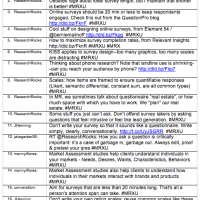Once you have taken the time to craft a fantastic questionnaire, the challenge becomes: how do you get people to actually take it? Of course, having a great list (or… Continue reading Please Take My Survey: Getting People to Accept Your Invitation
Once you have taken the time to craft a fantastic questionnaire, the challenge becomes: how do you get people to actually take it? Of course, having a great list (or… Continue reading Please Take My Survey: Getting People to Accept Your Invitation
Is your organization doing more market research? Are people outside of the market research department becoming increasingly involved in research, either as “do it yourself” researchers or as members of cross-functional project teams? Imagine a baseball team made up of three professional ball players and six middle-aged guys from the local coffee shop. Wouldn’t those well-intentioned coffee drinkers need some practice before that first game? Well if you want your whole research team to play at their best, here are a few things to keep in mind:
We get a lot of questions from people evaluating online survey platforms. And given that there are now more than 50 options available (see partial list at the end of this article), it is a bit confusing. Before you start evaluating options, consider these checklist items:

Even if a market research project produces a pile of perfect data, we still face the fundamental challenge of analysis — making sure that we’re analyzing the results comprehensively and objectively. In other words, without bias.
Let’s say you’ve done an online survey. You identified your objectives, thought carefully about sampling, and designed a great questionnaire. You monitored data collection and carefully cleaned your dataset. Even after all this painstaking work, risk still exists. You still have to analyze the data, and it’s here that unexpected errors often creep in.
When bad surveys are circulated, the company that sent them out becomes less trusted. The “consumer” becomes an unhappy customer, and may even tell others about their bad experience—with surveys in general or with the specific company.
Typically when we think about market research surveys, we think of questionnaires that have 20, 30, or even more questions. Getting qualified people to complete these questionnaires has become a serious challenge. One alternative is the single-question poll. After all, you’re much more likely to get high response and low dropout rates if you can simply say, “Hi, we have a single question we’d like your opinion on”, rather than requesting a novel’s worth of responses.
Facebook is making polling insanely easy these days…
Do you cringe when you hear the word “policies”? Most people do. After all, policies often mean bureaucracy. But in the case of market research, clear policies will minimize the risk of data quality headaches, customer over-surveying, ethical breaches and more.
In a crowded marketplace, how can market research help your company stand out? By doing things your competitors aren’t daring enough to try. So let’s have some fun.

During the January 11th Twitterversity, one of the topic areas was, “About Survey Projects.”
Below is an excerpt from that section. The posts are from myself (@ResearchRocks), Annie Pettit (@Conversition), Manny Flores and Jeffrey Henning.

I saw some great interest this morning in the idea of a survey grading site. Inspired by yet another awful questionnaire design (one that had been sent to the market research community itself, ironically), I threw out the idea half-joking.
I was thrilled to see responses to the idea from great tweeps like @MDMktingSource @conversition @MargaretRoller.
Could this crazy idea have legs?
One idea: Perhaps a volunteer committee of 6 experienced researchers would get together once a month or so (virtually, of course), to review and grade questionnaires?